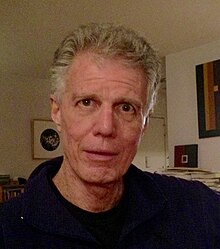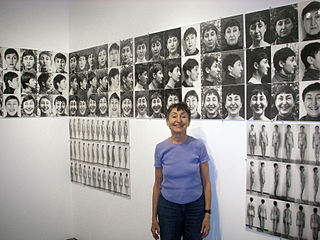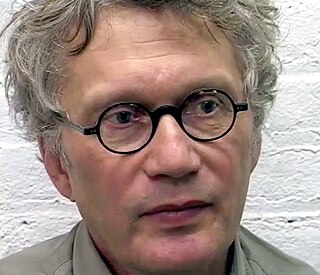
Robert C. Morgan (born 1943) is an American art critic, art historian, curator, poet, and artist.

Robert C. Morgan (born 1943) is an American art critic, art historian, curator, poet, and artist.
Robert C. Morgan received his M.F.A. in sculpture from the University of Massachusetts, Amherst in 1975 and his Ph.D. in art education from New York University in 1978. Professor Morgan has had an extensive academic career. He has taught at New York University, Wichita State University, the University of Rochester, the School of Visual Arts, Barnard College, and Columbia University. From 1981- 2001, he was Professor of the History and Theory of Art at the Rochester Institute of Technology. He is currently an adjunct professor of Fine Arts in the Graduate School of Fine Arts at Pratt Institute in Brooklyn, New York.
Morgan has worked extensively as an independent curator. He has organized museum retrospectives of Allan Kaprow (1979) and Komar and Melamid (1980), both at the Ulrich Museum of Art in Kansas. In 1990, he curated Concept -- Decoratif in conjunction with the Holly Solomon Gallery in New York. From 1989 to 1990, he directed a gallery in SoHo (New York) where he curated a dozen exhibitions of both emerging and established artists, including Carolee Schneemann, Nancy Grossman, Hung Liu, Hong-Wen Lin, Robert Barry, Douglas Huebler, Mel Bochner, Antoni Muntadas, and Max Ernst. In 1994, he co-organized the exhibition Logo Non Logo with French critic Pierre Restany at the Thread Waxing Space in New York, which later traveled to the Art Museum of the University of South Florida in Tampa, Florida.
Morgan has authored numerous books, catalogs and monographs on contemporary artists in various countries. His book on the American conceptualist Robert Barry was published by Karl Kerber Press in Bielefeld, Germany (1986). Haim Steinbach was published by the Musee d’Art Contemporain, Bordeaux (1988). Duchamp, Androgyny, Etc., (on Marcel Duchamp) was published by Editions Antoine Candau in Paris (1990). A Hans Bellmer Miscellany was published by Baum/Malmburg in Malmö, Sweden in 1993. His Turkish Bath installation at Artists Space in 1976 has been recognized an early example of post-conceptual art.
Morgan frequently writes art criticism for the Brooklyn Rail. His books and collected critical essays published include commentaries on conceptual art, post-conceptual art and the new media arts (Umbrella Associates, 1992). He has published the following books in the United States: After the Deluge: Essays on the Art of the Nineties, (Red Bass Publications, 1993), Conceptual Art: An American Perspective (McFarland, 1994); Art into Ideas: Essays on Conceptual Art (Cambridge University Press, 1996), Between Modernism and Conceptual Art (McFarland, 1997): and The End of the Art World (Allworth Press, 1998).
His critical anthologies on Gary Hill (2000) and Bruce Nauman (2002) were published by Johns Hopkins University Press. An edited volume of the late writings by the critic Clement Greenberg was published by the University of Minnesota Press in 2003. In 1995, he traveled to Korea on a Fulbright Fellowship. [1]

Modernism is an early 20th-century movement in literature, visual arts, and music that emphasized experimentation, abstraction, and subjective experience. Philosophy, politics, and social issues were also aspects of the movement, which sought to change how “human beings in a society interact and live together”.

Installation art is an artistic genre of three-dimensional works that are often site-specific and designed to transform the perception of a space. Generally, the term is applied to interior spaces, whereas exterior interventions are often called public art, land art or art intervention; however, the boundaries between these terms overlap.

Conceptual art, also referred to as conceptualism, is art in which the concept(s) or idea(s) involved in the work are prioritized equally to or more than traditional aesthetic, technical, and material concerns. Some works of conceptual art may be constructed by anyone simply by following a set of written instructions. This method was fundamental to American artist Sol LeWitt's definition of conceptual art, one of the first to appear in print:
In conceptual art the idea or concept is the most important aspect of the work. When an artist uses a conceptual form of art, it means that all of the planning and decisions are made beforehand and the execution is a perfunctory affair. The idea becomes a machine that makes the art.

Postmodern art is a body of art movements that sought to contradict some aspects of modernism or some aspects that emerged or developed in its aftermath. In general, movements such as intermedia, installation art, conceptual art and multimedia, particularly involving video are described as postmodern.
Hans Bellmer was a German artist, best known for his drawings, etchings that illustrates the 1940 edition of Histoire de l’œil, and the life-sized female dolls he produced in the mid-1930s. Historians of art and photography also consider him a Surrealist photographer.

Michael Corris is an artist, art historian and writer on art. He is professor emeritus of art, Division of Art, Meadows School of the Arts, Southern Methodist University, Dallas, Texas, United States. Previously, Corris held the post of Professor of Fine Art at the Art and Design Research Center, Sheffield Hallam University. From 2005-6, he was a Visiting Professor of Art Theory at the Bergen Art Academy.
Michael Martin Fried is a modernist art critic and art historian. He studied at Princeton University and Harvard University and was a Rhodes Scholar at Merton College, Oxford. He is the J.R. Herbert Boone Professor Emeritus of Humanities and Art History at the Johns Hopkins University, Baltimore, Maryland, United States.
Mel Bochner is an American conceptual artist. Bochner received his BFA in 1962 and honorary Doctor of Fine Arts in 2005 from the School of Art at Carnegie Mellon University. He lives in New York City.

Joseph Nechvatal is an American post-conceptual digital artist and art theoretician who creates computer-assisted paintings and computer animations, often using custom-created computer viruses.

Marcia Tucker was an American art historian, art critic and curator. In 1977 she founded the New Museum of Contemporary Art, a museum dedicated to innovative art and artistic practice in New York City, which she ran as the director until 1999.
Lucy Rowland Lippard is an American writer, art critic, activist, and curator. Lippard was among the first writers to argue for the "dematerialization" at work in conceptual art and was an early champion of feminist art. She is the author of 21 books on contemporary art and has received numerous awards and accolades from literary critics and art associations.

Johanna Drucker is an American author, book artist, visual theorist, and cultural critic. Her scholarly writing documents and critiques visual language: letterforms, typography, visual poetry, art, and lately, digital art aesthetics. She is currently the Martin and Bernard Breslauer Professor in the Department of Information Studies at the Graduate School of Education and Information Studies at UCLA. In 2023, she was elected to the American Philosophical Society.
In the visual arts, late modernism encompasses the overall production of most recent art made between the aftermath of World War II and the early years of the 21st century. The terminology often points to similarities between late modernism and postmodernism, although there are differences. The predominant term for art produced since the 1950s is contemporary art. Not all art labelled as contemporary art is modernist or post-modern, and the broader term encompasses both artists who continue to work in modern and late modernist traditions, as well as artists who reject modernism for post-modernism or other reasons. Arthur Danto argues explicitly in After the End of Art that contemporaneity was the broader term, and that postmodern objects represent a subsector of the contemporary movement which replaced modernity and modernism, while other notable critics: Hilton Kramer, Robert C. Morgan, Kirk Varnedoe, Jean-François Lyotard and others have argued that postmodern objects are at best relative to modernist works.

Athena Tacha, is a multimedia visual artist. She is best known for her work in the fields of environmental public sculpture and conceptual art. She also worked in a wide array of materials including stone, brick, steel, water, plants, and L.E.D. lighting. photography, film, and artists’ books. Tacha's work focused on personal narratives, and often plays with geometry and form.
Charles Townsend Harrison, BA Hons (Cantab), MA (Cantab), PhD (London) was a UK art historian who taught Art History for many years and was Emeritus Professor of History and Theory of Art at the Open University. Although he denied being an artist himself, he was a full participant and catalyst in the Art and Language group.
Peter Osborne is a British philosophy teacher who is Professor of Modern European Philosophy and Director of the Centre for Research in Modern European Philosophy (CRMEP), Kingston University, London. He is a former editor of the journal Radical Philosophy.

Bill Beckley is an American narrative and conceptual artist.
Post-conceptual, postconceptual, post-conceptualism or postconceptualism is an art theory that builds upon the legacy of conceptual art in contemporary art, where the concept(s) or idea(s) involved in the work takes some precedence over traditional aesthetic and material concerns. The term first came into art school parlance through the influence of John Baldessari at the California Institute of the Arts in the early 1970s. The writer Eldritch Priest, specifically ties John Baldessari's piece Throwing four balls in the air to get a square from 1973 as an early example of post-conceptual art. It is now often connected to generative art and digital art production.

The Real Estate Show was a squatted exhibition by New York artists' group Colab, on the subject of landlord speculation in real estate held on New Year's Day in a vacant city-owned building at 123 Delancey Street in the Lower East Side of Manhattan, New York City.
Donald Burgy is an American conceptual artist, author, and teacher. He is Professor Emeritus in the Studio for Interrelated Media at Massachusetts College of Art and Design in Boston. He earned a Bachelor of Fine Arts from the Massachusetts College of Art and Design in Boston in 1959 and a Master of Fine Arts from Rutgers University in 1963. Burgy began his teaching career in 1960 teaching art in public schools in Quincy and Chicopee in MA, and in Brentwood, NY. From 1966 - 1973, Burgy taught Art History and Art Studio at the Bradford Junior College in Bradford, MA. He was the chair of the Art Department at Milton Academy in Milton, MA from 1973 - 1975. Burgy taught Studio Art at Harvard University before his tenure at the Massachusetts College of Art and Design in the Studio for Interrelated Media in Boston from 1971 until 2001. Donald Burgy has studied neurology, cosmology, and Paleolithic art as the basis for his conceptual artwork since 1969.